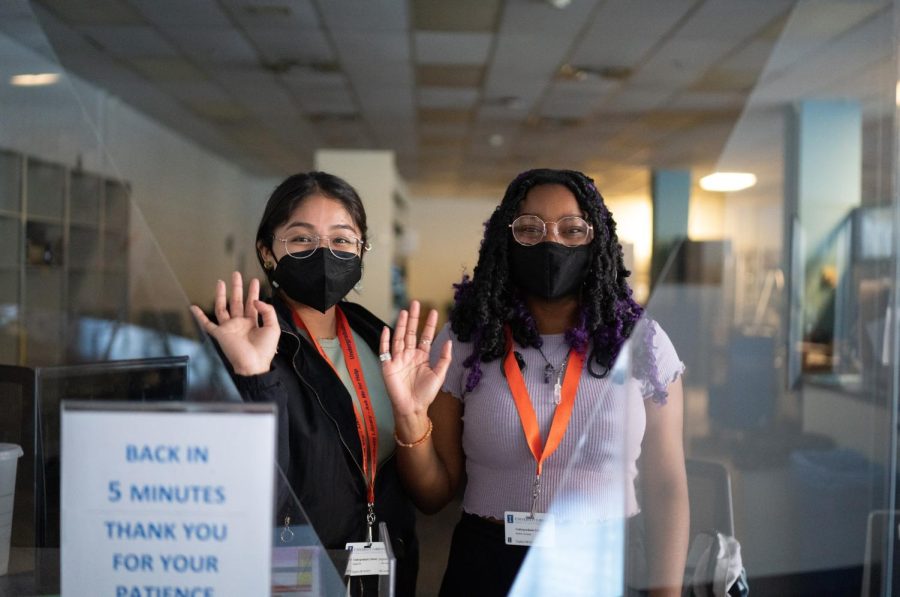Books, breaks left behind: Last students in UGL share thoughts
Vanessa Blas, junior in Engineering, and Selena Alena, junior in Media, are Undergraduate Library student assistants, and are two of the last people to work at the UGL as operations at the library close on Friday.
May 17, 2022
Last Friday, the Undergraduate Library opened its doors for the final time. Shortly before closing, a few students could be seen working and chatting with friends, some unaware they would be the last people in the building before it closed its doors for good.
Angelo Eugenides, junior in LAS, said they were not aware the UGL was closing.
“I did not even know that,” Eugenides said. “I’m just doing some stuff around my internship right now, but it’s really weird not going to have this place where I studied for the past three years. It’s just ingrained in me to go here when I need to study.”
Like many students, the UGL is Eugenides’ preferred choice for a study place, where he said he spends up to 10 hours weekly. Other than its prime location, UGL’s unique background drew him in.
“I think it’s interesting to have the UGL underground, you know, and especially the history with the Morrow Plots, which is really cool,” Eugenides said. “So yeah, I think it’s a really good building.”
Get The Daily Illini in your inbox!
Serena Suni, junior in LAS, said she shares Eugenides’ preference for the UGL, even though she lives closer to other libraries.
“It’s just been a nice place to study while I’ve been at (the University), Suni said. “I’m a computer science major, so I see enough engineers in my day-to-day life, so sometimes I like coming to the UGL to be around ‘normal’ students.”
Suni said that while the UGL closing is sad, she has other options.
“I’m, like, a little sad, but I’ll probably just go to the Main Library now,” Suni said. “It doesn’t really affect me.”
Selena Adetunji, sophomore in Media, worked as a staff member at the UGL. As a circulation desk student assistant, she helped students with their library needs but also got to witness visitors’ interactions from the front desk.
“It feels a little bittersweet,” Adetunji said. “It’s a little surreal. Alumni will come in with their kids and be like, ‘Oh, I used to study here for finals.’ But it’s very nice to see how far everything is coming.”
Adetunji will continue working at the circulation desk next semester in the new designated space.
“We have a space in the main library,” Adetunji said. “It’s basically like a mini UGL. It’s going to be somewhat different, but it’s going to be the same (services) and places for people to study and hang out with their friends.”
Megan Tafalla, freshman in DGS, voiced concerns about space. Living in the dorms, the UGL was the most accessible study space for her.
“I’m not really thrilled about the move,” Tafalla said. “It’s currently a nice central location for a lot of students. I feel like that will affect people from PAR, like the southernmost dorms, because they’ll have to go further to the other libraries.”
Aside from the location, Tafalla said she prefers the atmosphere and the layout of the UGL over other libraries such as Grainger.
“I don’t know if you’ve ever studied in Granger in finals week, but it gets pretty nasty in there,” Tafalla said. “It gets very crowded, and so my one concern is that there’s just not going to be enough space for undergrads to be able to study comfortably. I’m concerned about the density because it will be a multi-year project.”
Tafalla said that she would be less concerned if the University was more transparent with its plans for the libraries.
“I guess I would feel better about it if there were more plans publicized about, like, how the seating is to be arranged,” Tafalla said. “But I’ve checked the library website a lot, and because they’re still figuring it, they don’t really have a lot of information on that.”
Tafalla said the UGL holds a special place in her heart, having spent at least three hours in the UGL every day and attending many library events such as rock painting and other student success events.
“People think about libraries as being kind of like static spaces where you just go in and check out your book, and then you leave,” Tafalla said. “But the thing about libraries that’s good too is that they can also be places where you can shape the community, and then the community can kind of shape the libraries.”






